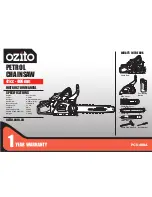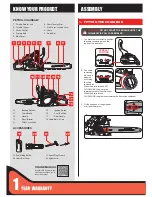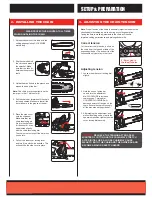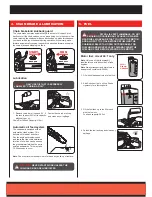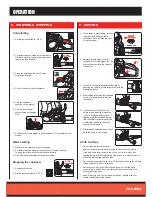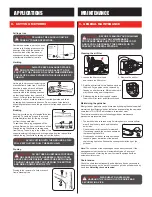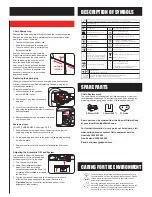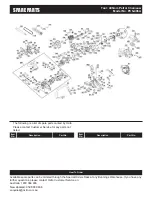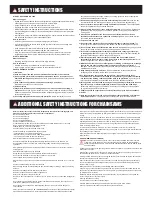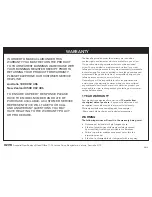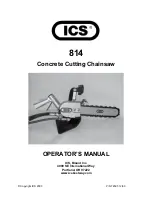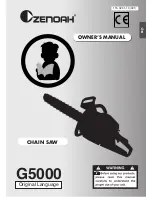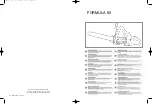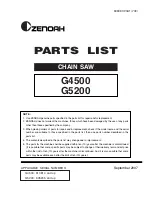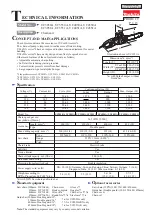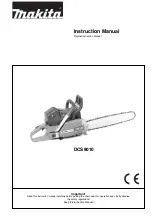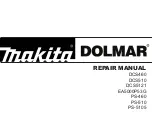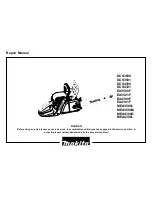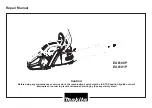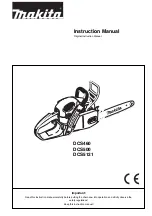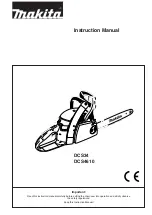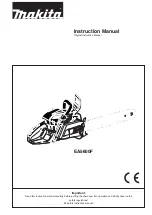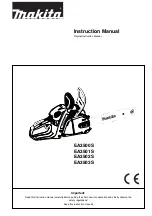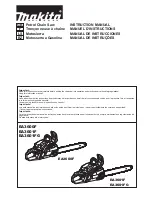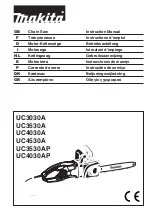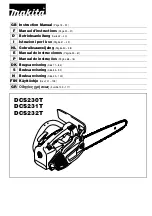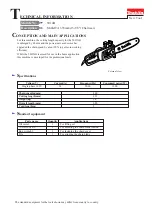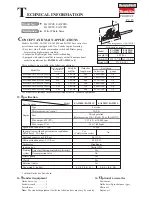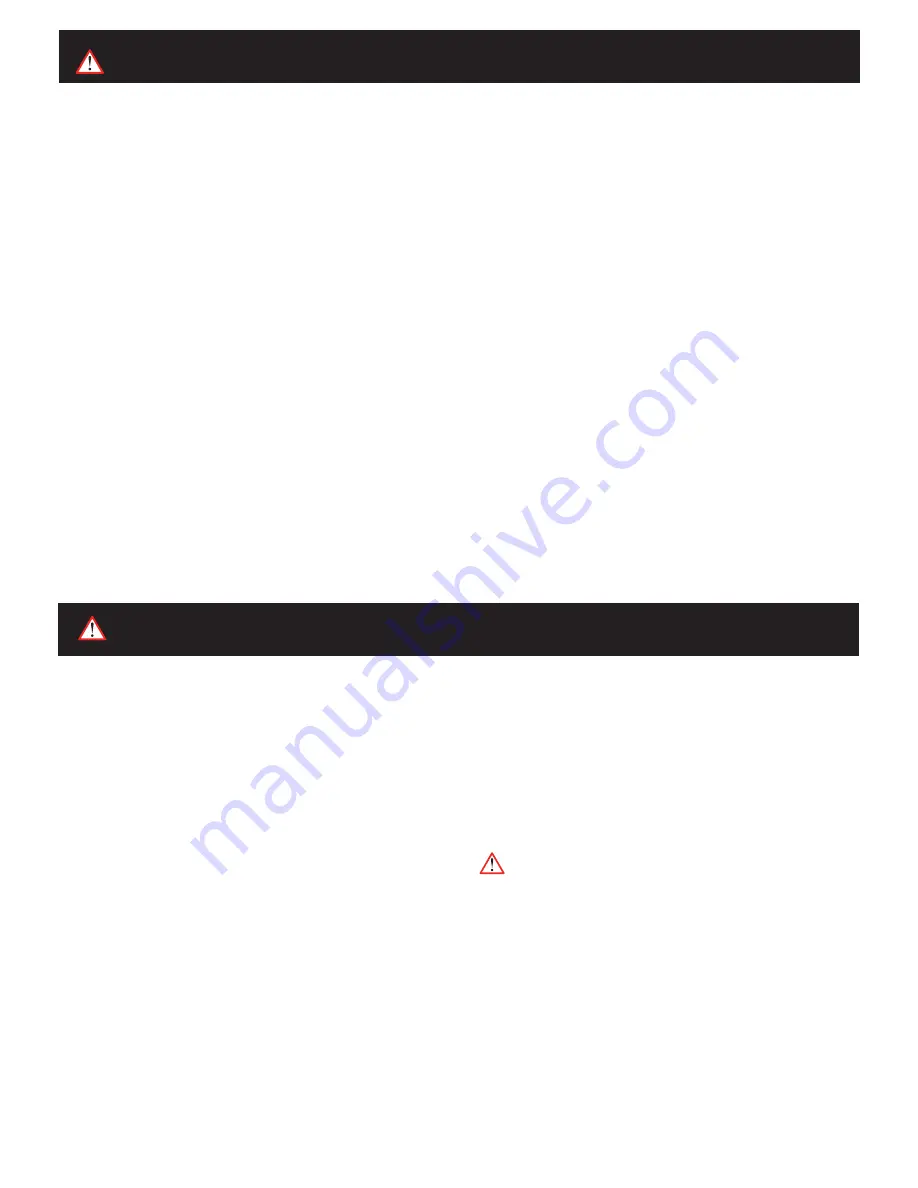
Note: For safety reasons the chainsaw is shipped with the chain brake fully engaged. This
brake must be released before the saw becomes operational.
Never cut into the ground.
Never cut into wire fences.
Never cut into samplings.
Never cut into prepared wood.
Use the chainsaw to cut only wood.
It is advisable to provide a support for the chainsaw when cutting branches. Do not cut using
the bar point and beware of branches under tension.
Children under 18 must not use chainsaws.
Keep people away from the chainsaw when in use.
Check the following conditions before beginning work:
• There should be no people in the felling area.
• Make sure there is a second person within calling distance.
• The working area should be free from obstacles.
Wear suitable clothes which do not hinder movement.
Use specific protection during operations involving head, hands, feet, eyes and ears. It is
recommended the use of a helmet with a visor during felling, branch cutting and chopping
operations.
Wear gloves with an external protection when using the chainsaw. Use ear protection to prevent
hearing injuries.
Wear safety boots when using the chainsaw.
During transport the brake must be applied to avoid accidental start-up.
Do not use the chainsaw in rainy or windy conditions or in poor light.
Find a suitable position before beginning work.
When working on slopes, the saw operator must stand beside or above the wood to cut, i.e. felled
trees.
Use the chainsaw holding it firmly with both hands.
Make a wedge-shaped cut before felling the tree, then the felling cut leaving a hinge for the felling
direction.
Beware of any falling branches after felling operations.
Beware of wood splinters when cutting chopped wood.
Ensure your chainsaw is suitable for the job.
Never work above shoulder level or reach out to cut a branch: ensure you have stable footing at all
times.
Do not operate in a hazardous location. Such areas include where there is a risk of explosion of
petrol fumes, leaking gas or explosive dust.
Do not operate in a confined area. Exhaust gases, smoke or fumes could reach dangerous
concentrations.
Protect your tool. This chainsaw is NOT WEATHERPROOF and should not be exposed to direct sunlight,
high ambient temperatures, damp, wet or high humidity conditions for prolonged periods of time.
Take care not to spill fuel. When refuelling the chainsaw ensure that the motor has been switched off.
Prevent the spilling of fuel as this may also ignite with the hot motor. Never refuel whilst the engine
running.
Be careful where you store the chainsaw. Store the tool in a dry area away from flammable liquids.
Keep your distance. The chainsaw emits exhaust fumes. Ensure bystanders keep a safe distance.
Operating instructions and instructions for common cutting tasks, including the use of personal
protection equipment are covered in this manual. This product has a need for adequate training
which is covered in this manual.
Do not operate this machine while tired, ill or under the influence of alcohol or other drugs.
Ensure that you mix 40 parts unleaded fuel to 1 part 2-stroke oil. If not, the engine will overheat and
cause damage to your chainsaw.
Never fill fuel tank indoors. Never fill fuel tank when engine is running or hot. Do not smoke when
filling fuel tank.
DANGER! BEWARE OF KICKBACK!
WARNING!
Kickback can lead to dangerous loss of control of the chainsaw and result in serious
or fatal injury to the operator or to anyone standing close by. Always be alert. Rotational
kickback and pinch kickback are major chainsaw operational dangers and the leading cause
of most accidents.
Kickback may occur when the tip of the guide bar touches an object, or when the wood closes in and
pinches the saw chain.
If the bar tip or point contacts, it can produce a rapid reverse reaction, kicking the guide bar up and
back towards the operator. This is known as rotational kickback.
Pinching the saw chain along the top of the guide bar may push the guide bar rapidly back towards
the operator. This is known as pinch kickback.
Either of these reactions can cause loss of control of the saw, resulting in serious personal injury.
Do not rely exclusively on the safety devices built into your saw. Take the following steps to help
avoid accident or injury:
Reduce the element of surprise by understanding what causes kickback.
Keep a firm grip on the chainsaw using both hands, the right hand on the rear handle and the left
hand on the front handle when the motor is running. A firm grip will help maintain control. Do not let
go whilst the motor is running.
Make sure that the area of operation is free of obstructions. Do not let the point of the guide bar
contact a log, branch or any other object.
Use high speeds when cutting.
Do not overreach or cut above shoulder height.
Carefully follow the sharpening and maintenance instructions given in this manual.
Use only replacement bars and chains specified by the manufacturer.
RISK OF EXPLOSION OR FIRE
What can happen:
• Spilled petrol and its vapours can become ignited from cigarette sparks, electrical arcing,
exhaust gases and hot engine components such as the muffler.
• Heat will expand fuel in the tank which could result in a fire.
• Operating the tool in an explosive environment could result in a fire.
• Muffler exhaust heat can damage painted surfaces, melt any materials sensitive to heat
(such as siding plastic, rubber or vinyl) and damage live plants. Keep hot tool away from
other objects.
• Improperly stored fuel could lead to accidental ignition. Fuel improperly secured could get
into the hands of children or other unqualified persons.
How to prevent it:
• Shut off engine and allow it to cool before adding fuel to the tank.
• Use care when filling the tank to avoid spilling fuel. Move tool away from fuelling area
before starting engine.
• Keep maximum fuel level 20mm below top of tank to allow for expansion.
• Operate and refuel in well ventilated areas free from obstructions.
• Store fuel in a approved container (AS/NZS 2906-1999) for petrol. Store in a secure
location away from the work area. Make sure the container is clearly marked “fuel”.
RISK TO BREATHING
What can happen:
• Breathing exhaust fumes can cause serious injury or death.
How to prevent it:
• Operate tool in a well ventilated area. Avoid enclosed areas.
• Never operate unit in a location occupied by other people or animals.
SAVE THESE INSTRUCTIONS
1) Work area
a) Keep work area clean and well lit. Cluttered and dark areas invite accidents.
b) Do not operate petrol tools in explosive atmospheres, such as in the presence of
flammable liquids, gases, or dust.
Power tools create sparks which may ignite the dust
or fumes.
c) Keep children and bystanders away while operating a petrol tool.
Distractions can cause you to lose control.
2) Personal safety
a) Stay alert, watch what you are doing and use common sense when operating a
petrol tool.
Do not use a power tool while you are tired or under the influence of drugs,
alcohol, or medication. A moment of inattention while operating power tools may result in
serious personal injury.
b) Use safety equipment. Always wear eye protection.
Safety equipment such as a
dust mask, non-skid safety shoes, hard hat, or hearing protection used for appropriate
conditions will reduce personal injuries.
c) Remove any adjusting key or wrench before turning the tool on.
A wrench or a key
that is left attached to a rotating part of the petrol tool may result in personal injury.
d) Do not overreach. Keep proper footing and balance at all times.
This enables better
control of the petrol tool in unexpected situations.
e) Dress properly. Do not wear loose clothing or jewellery.
Keep your hair, clothing and
gloves away from moving parts. Loose clothes, jewellery or long hair can be caught in
moving parts.
f) If devices are provided for the connection of dust extraction and collection
facilities ensure that these are connected and properly used.
Use of these devices
can reduce dust-related hazards.
3) Petrol tool use and care
a) Do not force the petrol tool. Use the correct petrol tool for your application.
The
correct petrol tool will do the job better and safer at the rate for which it was designed.
b) Do not use the petrol tool if the switch does not turn it on and off.
Any petrol tool that
cannot be controlled with the switch is dangerous and must be repaired.
c) Turn tool off completely before making any adjustments, changing accessories,
or storing petrol tools.
Such preventive safety measures reduce the risk of starting the
petrol tool accidentally. Hair can be caught in moving parts.
d) Store idle petrol tools out of the reach of children and do not allow persons
unfamiliar with the petrol tool or these instructions to operate the petrol tool.
Petrol
tools are dangerous in the hands of untrained users.
e) Maintain petrol tools. Check for misalignment or binding of moving parts, breakage
of parts and any other condition that may affect the petrol tool’s operation.
If
damaged, have the petrol tool repaired before use. Many accidents are caused by poorly
maintained petrol tools.
f) Keep cutting tools sharp and clean.
Properly maintained cutting tools with sharp
cutting edges are less likely to bind and are easier to control.
g) Use the petrol tool, accessories and tool bits etc., In accordance with these
instructions and in the manner intended for the particular type of petrol tool, taking
into account the working conditions and the work to be performed.
Use of the petrol
tool for operations different from intended could result in a hazardous situation.
h) This appliance is not intended for use by persons (including children) with reduced
physical, sensory or mental capabilities, or lack of experience and knowledge,
unless they have been given supervision or instruction concerning use of the appliance
by a person responsible for their safety.
i) Children should be supervised to ensure that they do not play with the appliance.
4) Service
a) Have your petrol tool serviced by a qualified repair personnel using only identical
replacement parts.
This will ensure that the safety of the petrol tool is maintained.
ADDITIONAL SAFETY INSTRUCTIONS FOR CHAINSAWS
SAFETY INSTRUCTIONS

